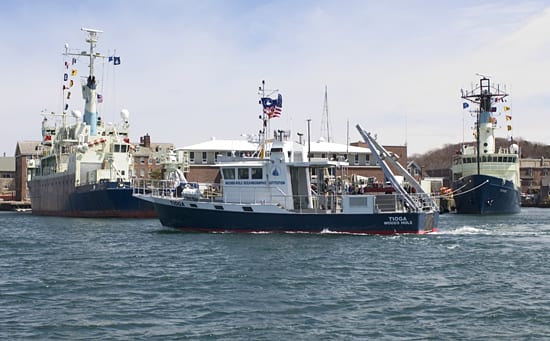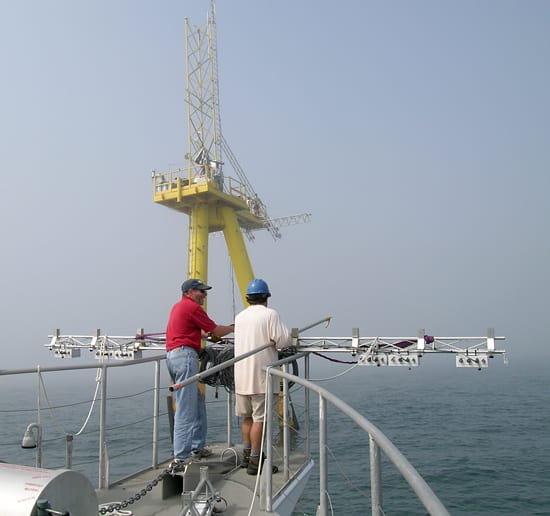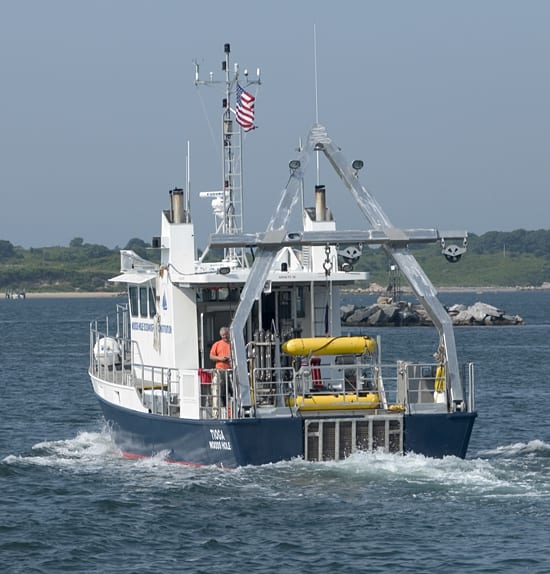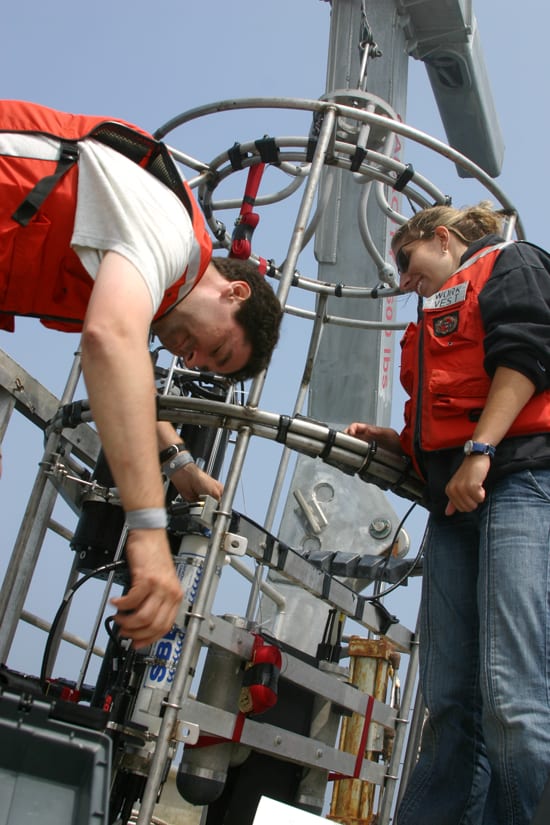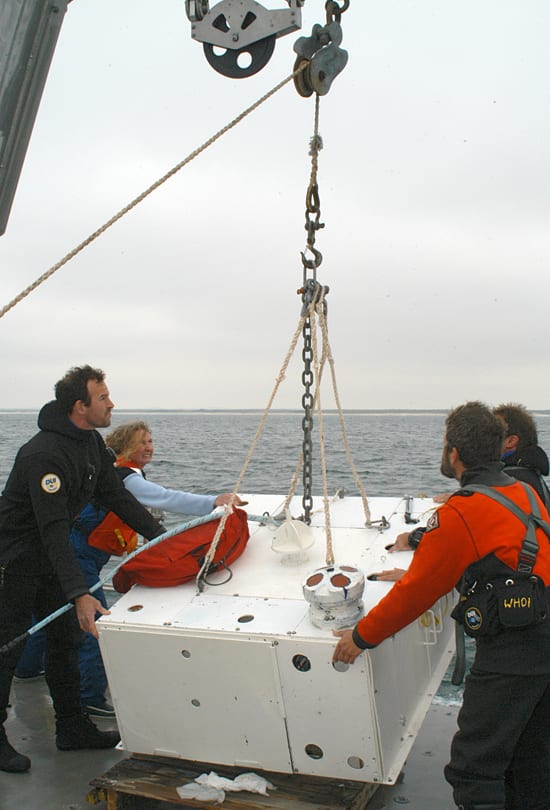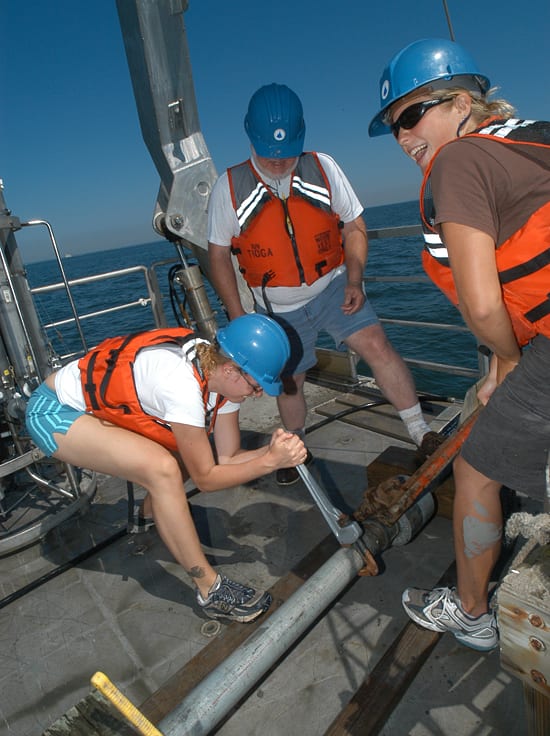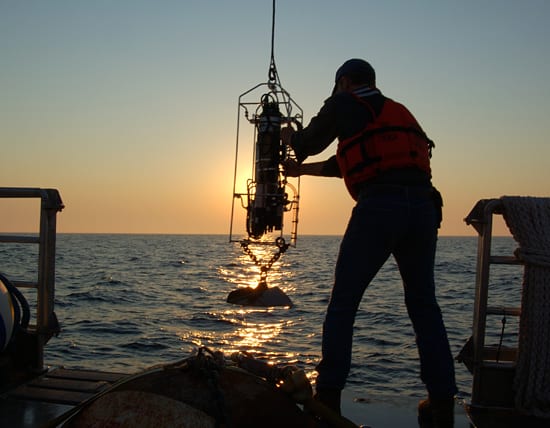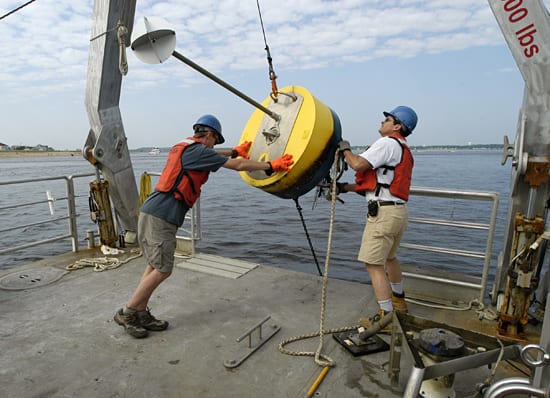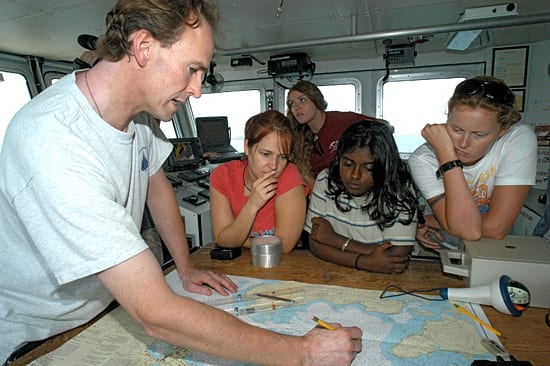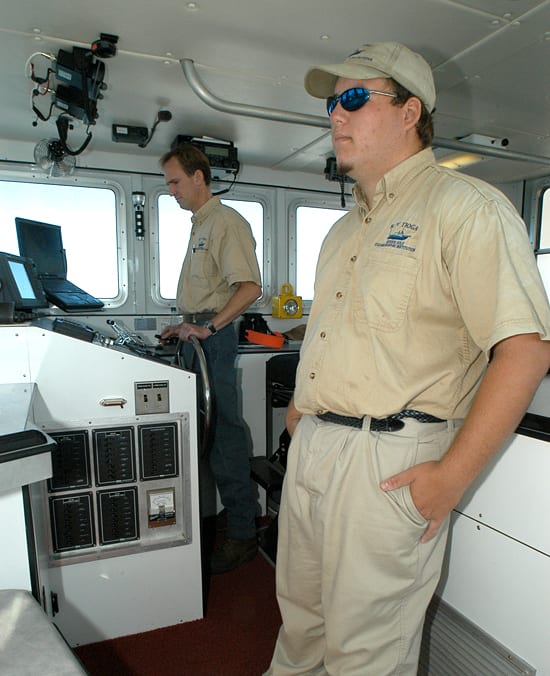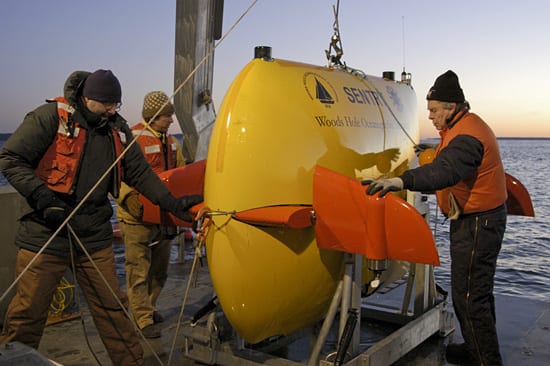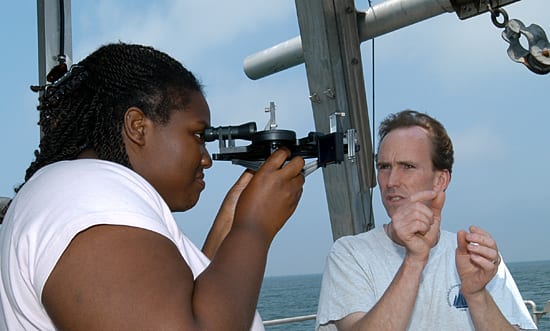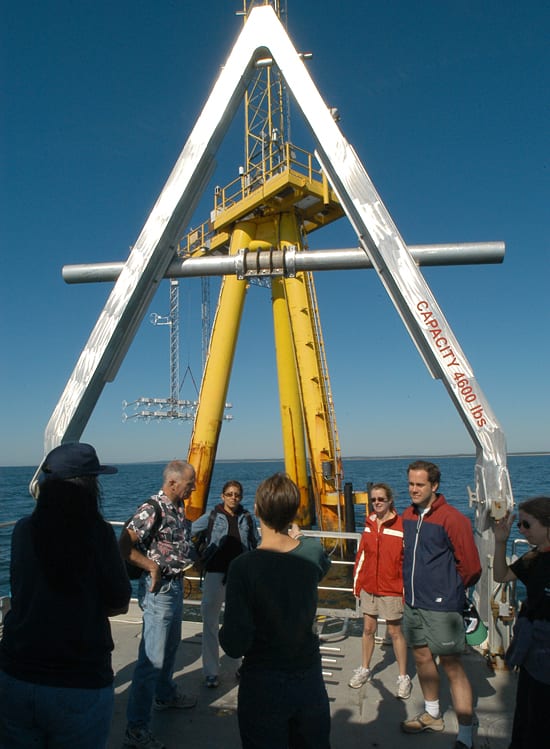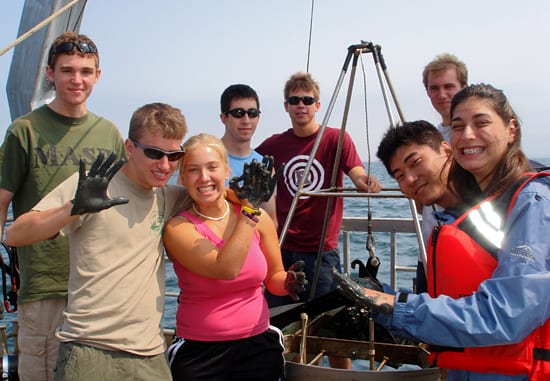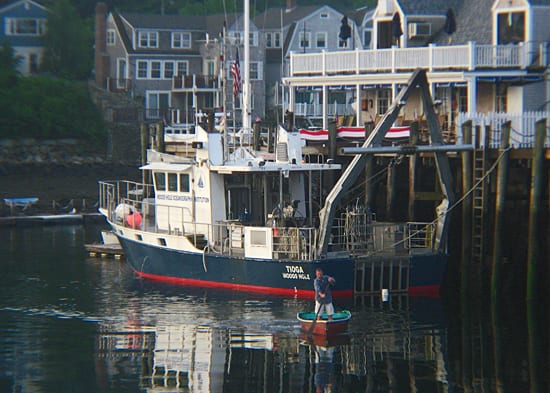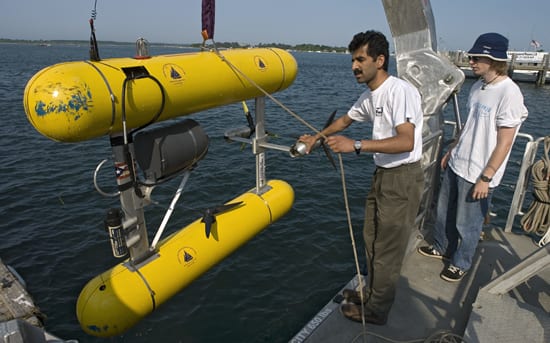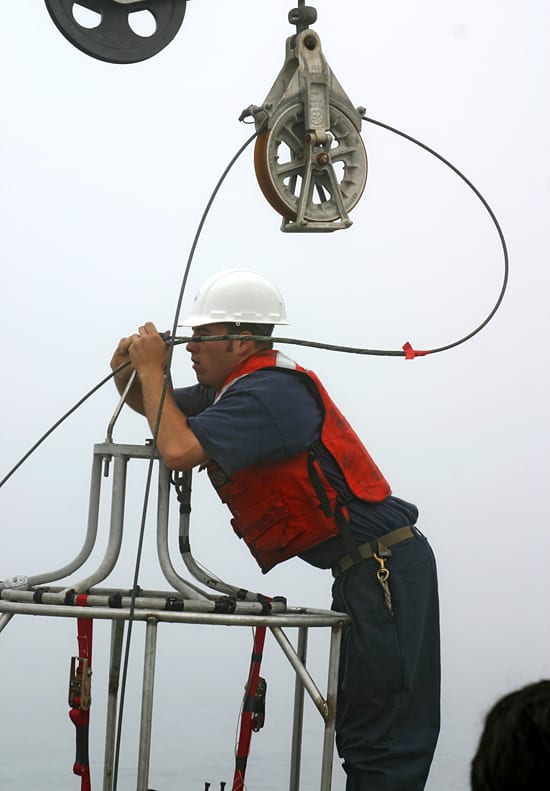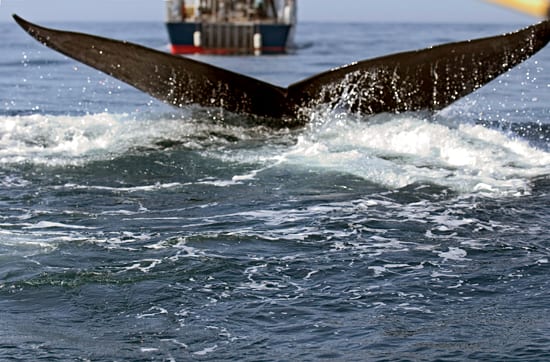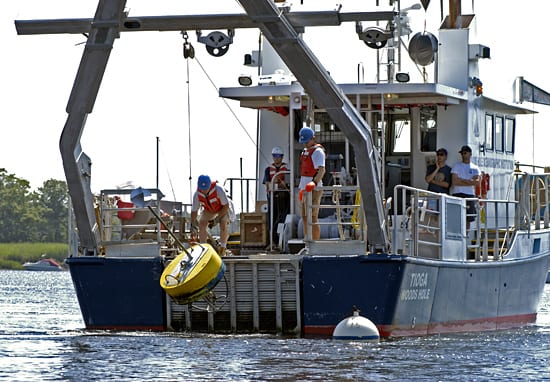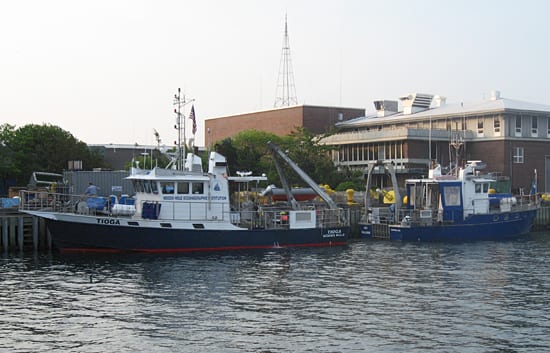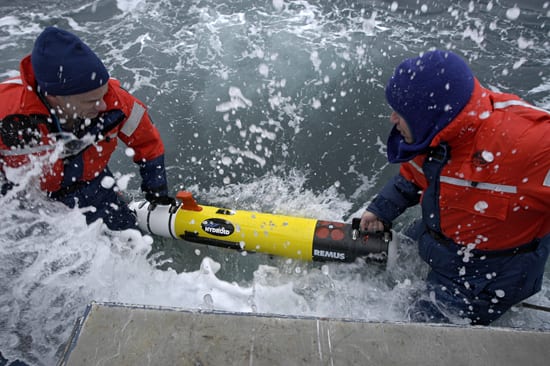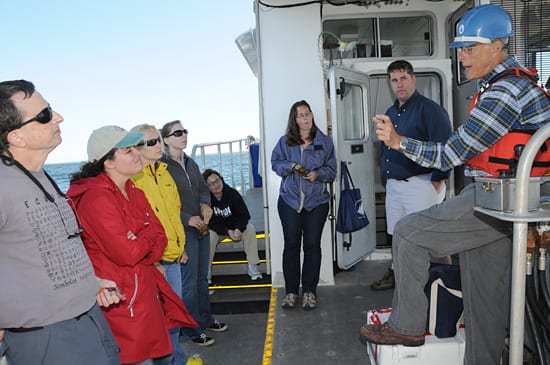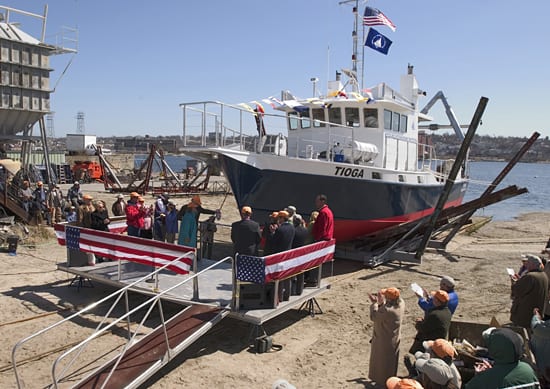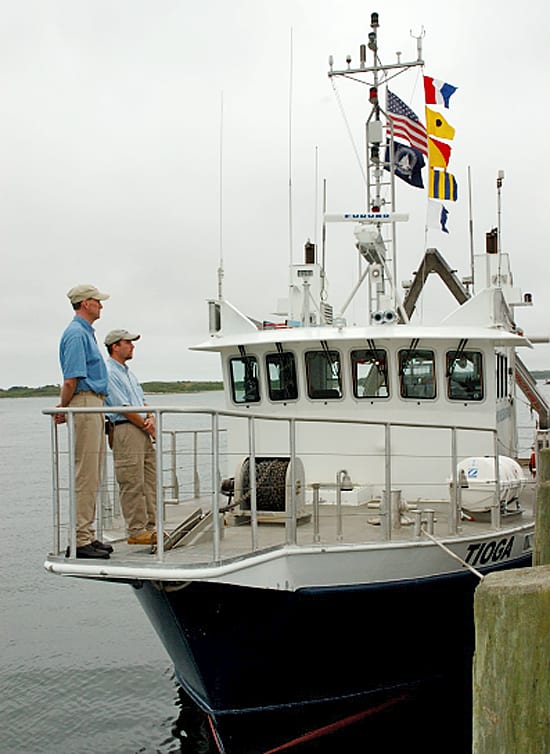Tioga Slideshow
- It may sound odd for an oceanographic institution, but it is actually an unusual occurrence when more than one research vessel is docked at WHOI's Iselin Marine Facility. The ships can spend upwards of 200-250 days per year plying the oceans, and not necessarily at the same time. In the spring of 2004, the then-brand new coastal vessel Tioga (middle) joined the Knorr (left) and Oceanus for a home port call in Woods Hole. (Photo by Tom Kleindinst, Woods Hole Oceanographic Institution)
- Meteorologists Tom Horst (National Center for Atmospheric Research) and Jim Edson (visiting scientist at WHOI, full time at University of Connecticut) hold tight to an array of acoustic anemometers as the research vessel Tioga approaches the Martha's Vineyard Coastal Observatory through the fog of a July morning. The researchers deployed the instruments on MVCO's air-sea interaction tower in the summer of 2004 to measure winds near the sea surface for the Ocean Horizontal Array Turbulence Study (OHATS). (Photo by Michael Carlowicz, Woods Hole Oceanographic Institution)
- The coastal research vessel Tioga leaves Woods Hole's Great Harbor with the autonomous underwater vehicle SeaBED strapped to its stern. Tioga is frequently used as a platform for taking new instruments and robotic vehicles out of their protected lab and shop birthplace and into real-life tests at sea. (Photo by Tom Kleindinst, Woods Hole Oceanographic Institution)
- Mark Baumgartner and Melissa Patrician repair a conductivity-temperature-depth (CTD) rosette on the coastal research vessel Tioga. The biologists use the CTD to detect the water properties and nutrients at various depths in the ocean to see how they correlate with the depths to which whales dive. Baumgartner and colleagues are trying to understand the conditions that not only cause whales to dive within an area, but to migrate to the region in the first place. (Photo by Amy Nevala, Woods Hole Oceanographic Institution)
- Scientists and technicians, working on the fantail of the coastal research vessel Tioga, deploy an undersea "node" near the Air-Sea Interaction Tower of the Martha's Vineyard Coastal Observatory. The nodes are like underwater power strips, allowing researchers to plug in undersea instruments for continuous electrical power and communications to shore-based labs. (Photo by Jayne Doucette, Woods Hole Oceanographic Institution)
- WHOI Summer Student Fellows Jessica Millar (left) and Skylar Bayer (right) work to disassemble a gravity corer after its recovery, while retired WHOI researcher and instructor Bruce Tripp looks on during an educational cruise in July 2007. In addition to lecture hall and lab instruction, WHOI educators work to make sure that every student gets a taste of seagoing work, often on the coastal research vessel Tioga. (Photo by Jayne Doucette, Woods Hole Oceanographic Institution)
- Frank Bahr deploys a conductivity/temperature/density instrument, or CTD, from the coastal research vessel Tioga off the New Jersey coast during a recent experiment. The instrument measures water temperature, salinity (salt content), and conductivity, and it is the primary tool for determining essential physical properties of sea water. (Photo by Christopher Linder, Woods Hole Oceanographic Institution)
- Postdoc Dave Ralston and Jay Sisson aboard coastal vessel Tioga recover a surface buoy from the Merrimack River. The round object at the top of the buoy is a radar reflector. (Photo by James Kent, Woods Hole Oceanographic Institution)
- Summer Student Fellows learn navigational techniques from Captain Ken Houtler on the bridge of the coastal research vessel Tioga. (Photo by Jayne Doucette, Woods Hole Oceanographic Institutio)
- Ken Houtler, captain of coastal research vessel Tioga, handles the wheel while first mate Ian Hanley joins him on watch. In March 2007, Houtler and Hanley cruised the 60-foot boat into 20-knot winds, rough seas, and air temperatures of 4°F—with sea spray freezing on the windows and railings—to help bring an injured colleague back home. Tioga made a rendezvous with the research vessel Knorr in order to evacuate its third mate, who had injured his hand during a rescue boat exercise on a research cruise 300 miles southeast of Cape Cod. (Photo by Jayne Doucette, Woods Hole Oceanographic Institution)
- WHOI engineers—[left to right] Andy Billings, Griff Outlaw, and Rod Catanach—prepare to test the Sentry autonomous underwater vehicle off of the coastal research vessel Tioga in December 2007. (Photo by Dana Yoerger, Woods Hole Oceanographic Institution)
- Ken Houtler, captain of the coastal research vessel Tioga, teaches Summer Student Fellow DeAnna McCadney how to use a sextant during a demonstration cruise in July 2006. Every summer, dozens of college undergraduates are selected to participate in a three-month program to conduct basic research and learn the ropes of oceanography. (Photo by Jayne Doucette, Woods Hole Oceanographic Institution)
- WHOI plankton ecologist Heidi Sosik (center, back to the camera) stands on the fantail of the coastal research vessel Tioga and explains ocean observatories and coastal dynamics to reporters participating in WHOI's annual Ocean Science Journalism program. Sosik serves as science director for the Martha's Vineyard Coastal Observatory, with its yellow air-sea interaction tower looming in the background. (Photo by Jayne Doucette, Woods Hole Oceanographic Institution)
- Summer Student Fellows and Minority Student Fellows enjoy a sampling trip onboard the 60-foot coastal research vessel Tioga. The fellowships, awarded to science and engineering students who have completed their junior or senior year of college, are part of WHOI's effort to provide experience and assistance to young people as they decide whether they want to pursue careers in oceanography. (Photo by Laishona Vitelli, Woods Hole Oceanographic Institution)
- Ian Hanley prepares the 60-foot R/V Tioga for arrival during a break in mooring recovery operations on the Merrimack River. (Photo by James Kent, Woods Hole Oceanographic Institution)
- The coastal research vessel Tioga takes shelter in late June 2008 at a dock in Rockport Harbor, Mass., where the tides can rise and fall by as much as eight feet. WHOI biology researchers Bruce Keafer and Kerry Norton had spent the day—and would spend the next—sampling for Alexandrium fundyense in the waters from Cape Ann to Cape Cod. The harmful algae had a prodigious bloom this spring, shutting down shellfish beds in much of New England, though weather patterns prevented it from reaching as far south as in the devastating bloom of 2005. (Photo by Ian Hanley, Woods Hole Oceanographic Institution)
- Associate Scientist Hanumant Singh (left) and student Zachary Berkowitz prepare the autonomous underwater vehicle (AUV) SeaBED for testing from the stern of R/V Tioga in Woods Hole. (Photo by Tom Kleindinst, Woods Hole Oceanographic Institutio)
- Deck hand Ian Hanley secures equipment on R/V Tioga during attempted right whale tagging off Georges Bank with biologist Mark Baumgartner. (Photo by Amy Nevala, Woods Hole Oceanographic Institution)
- A North Atlantic right whale dives astern of WHOI's coastal vessel Tioga during a research cruise to study their feeding. Vulnerable to ship strikes and entanglement in fishing gear, the whales are among the world's most endangered mammals, with about 350 remaining. (Photo by Michael Moore, Woods Hole Oceanographic Institution)
- Stern view of the RV Tioga during a mooring recovery on the Merrimack River. (Photo by James Kent, Woods Hole Oceanographic Institution)
- The coastal research vessels Tioga (left) and Gulf Challenger enjoyed a June 2007 reunion at the WHOI pier. Operated by the University of New Hampshire, Gulf Challenger was designed and built by the same team (Roger Long Marine Architecture and Gladding-Hearn Shipbuilding) that built Tioga. The boats were designed as speedy but sturdy workhorses for marine research on the continental shelf from Maine to the Hudson River. (Photo by Ian Hanley, Woods Hole Oceanographic Institution)
- Al Plueddemann and Glen Gawarkiewicz prepare to launch REMUS, an autonomous underwater vehicle, from R/V Tioga during a survey in shallow water off Chatham, Mass., in early 2006. (Photo by Christopher Linder, Woods Hole Oceanographic Institution)
- WHOI scientist emeritus Sandy Williams describes the Modular Acoustic Velocity Sensor (MAVS) to the 2008 class of WHOI Ocean Science Journalism Fellows. Williams and physical oceanographer Jim Churchill led the writers on short cruise on the research vessel Tioga to deploy the MAVS and other sensors to measure current patterns and cycles in Buzzards Bay. From left to right: Peter Brown (Scientific American), Sarah Webb (freelance), Alexa Elliott (WPBT Miami), Kirsten Weir Taylor (freelance), Erin Koenig (WHOI media relations), Lauren Morello (ClimateWire), Mike Carlowicz (WHOI media), and Williams. (Photo by Jayne Doucette, Woods Hole Oceanographic Institution)
- WHOI employees, benfactors, and shipyard workers gathered on March 29, 2004, for the ceremonial blessing and launch of the coastal research vessel Tioga. The name Tioga comes from the Iroquois for "swift current"; it is also a Seneca word meaning "the meeting of two rivers." Both are fitting for a boat that can cruise at more than 20 knots and can range from the Hudson River to the shores of Maine. (Photo by Tom Kleindinst, Woods Hole Oceanographic Institution)
- Captain Ken Houtler and mate Ian Hanley stand on the bow of their vessel, the R/V Tioga, for a good view of the dockside during an August 2007 press conference about WHOI's role in the National Science Foundation's Ocean Observatories Iniative. WHOI's fast, versatile coastal research boat is designed for day and overnight trips for oceanography in coastal waters. Tioga's diverse resume includes frequent visits to the Martha's Vineyard Coastal Observatory; plying coastal waters to sample for harmful algal blooms; an in-the-water necropsy of a dead whale; and an emergency at-sea transfer of a crew member from another WHOI ship, the R/V Knorr, in the middle of the night. (Photo by Sean Whelan, Woods Hole Oceanographic Institution)
Image and Visual Licensing
WHOI copyright digital assets (stills and video) contained on this website can be licensed for non-commercial use upon request and approval. Please contact WHOI Digital Assets at images@whoi.edu or (508) 289-2647.

